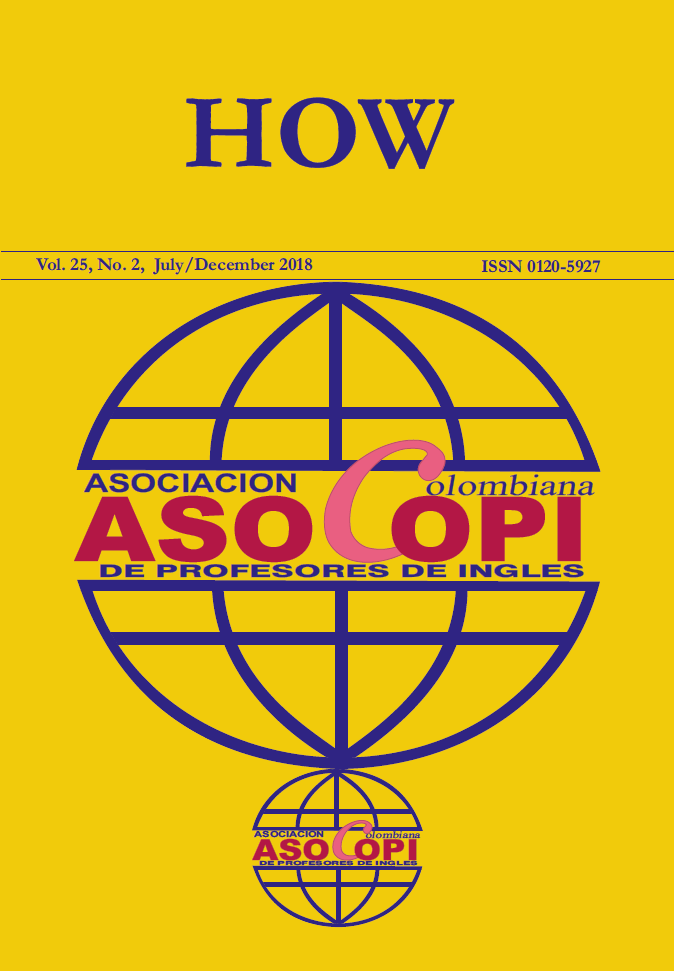The Role of Language in the Identity Formation of Transnational EFL Teachers
Main Article Content
Abstract
This research report presents the results of a qualitative study carried out at the Universidad de Guanajuato in central Mexico. Its purpose was to examine the process of identity formation of return migrants who lived a number of years in the United States and are currently studying for a BA in TESOL in Mexico. The participants use their knowledge of the English language to be able to reinsert themselves in society once they have returned to live in the country. Through narrative inquiry using autobiographies and semi-structured interviews, the study focuses on how language might influence the way in which individuals perceive themselves. Implications on family, ethnic associations, and school experiences were found.
Article Details

This work is licensed under a Creative Commons Attribution-NonCommercial-NoDerivatives 4.0 International License.
The authors of the manuscripts accepted for publication in HOW journal are required to sign a nonexclusive license agreement allowing ASOCOPI to reproduce the full text on the Internet or in any other available source. Authors retain copyright of their manuscripts with the following restrictions: first publication is granted to ASOCOPI; nonexclusive agreements with third parties can be established as long as the original publication in the HOW journal is properly acknowledged.
References
Bernal, M. E., & Knight, G. P. (Eds.). (1993). Ethnic identity: Formation and transmission among Hispanics and other minorities. Albany, US: State University of New York Press.
Berry, J. W. (1990). Psychology of acculturation. In J. J. Berman (Ed.), Nebraska Symposium on Motivation: Cross-cultural perspectives (pp. 201-234). Lincoln, US: University of Nebraska Press.
Bierman, K. L., Domitrovich, C. E., Nix, R. L., Gest, S. D., Welsh, J. A., Greenberg, M. T., & Gill, S. (2008). Promoting academic and social‐emotional school readiness: The Head Start REDI program. Child Development, 79(6), 1802-1817. https://doi.org/10.1111/j.1467-8624.2008.01227.x.
Boroianu, S. F. (2008). “She called me a Mexican!”: A study of ethnic identity (Doctoral dissertation). University of Northern Iowa, USA.
Bucholtz, M., & Hall, K. (2004). Language and identity. In A. Duranti (Ed.), A companion to linguistic anthropology (pp. 368-394). Malden, US: Blackwell Publishing.
Buckingham, D. (2008). Introducing identity. In D. Buckingham (Ed.), Youth, identity, and digital media (pp. 1-24). Cambridge, US: The MIT Press.
Cornejo Espejo, J. (2012). Educación, interculturalidad y ciudadanía [Education, interculturality, and citzenship]. Educar em Revista, Curitibia, Brasil, 43, 239-254. https://doi.org/10.1590/S0104-40602012000100016.
Creswell, J. W. (2012). Qualitative inquiry and research design: Choosing among five approaches. London, UK: Sage.
Dervin, F. (2008). Métamorphoses identitaires en situation de mobilité. Turku, FI: Humanoria.
Dervin, F., & Gao, G. (2012) Constructing a fairy tale around intercultural couplehood on Chinese television. Language and Intercultural Communication, 12(1), 6-23. https://doi.org/10.1080/14708477.2011.630471.
Devos, T. (2006). Implicit bicultural identity among Mexican American and Asian American college students. Cultural Diversity and Ethnic Minority Psychology, 12(3), 381-402. https://doi.org/10.1037/1099-9809.12.3.381.
Falicov, C. J. (2007). Working with transnational immigrants: Expanding meanings of family, community, and culture. Family Process, 46(2), 157-171. https://doi.org/10.1111/j.1545-5300.2007.00201.x.
Hatch, J. A., & Wisniewski, R. (Eds.). (2002). Life history and narrative. Washington, D.C.: Routledge.
Holliday, A. (2010). Intercultural communication and ideology. London, UK: Sage.
Holmes, J. (1992). An introduction to sociolinguistics. New York, US: Routledge.
LaBarbera, M. C. (2015). Identity and migration: An introduction. In M. C. LaBarbera (Ed.), International perspectives on migration (pp. 1-13). Berlin, DE: Springer International Publishing.
Mirdal, G. M., & Ryynänen-Karjalainen, L. (2004). Migration and transcultural identities. Strasbourg, FR: European Science Foundation.
Moll, L. C., Amanti, C., Neff, D., & Gonzalez, N. (1992). Funds of knowledge for teaching: Using a qualitative approach to connect homes and classrooms. Theory Into Practice, 31(2), 132-141. https://doi.org/10.1080/00405849209543534.
Padilla, A. M. (1994). Bicultural development: A theoretical and empirical examination. In R. G. Malgady & O. Rodriguez (Eds.), Theoretical and conceptual issues in Hispanic mental health (pp. 20-51). Melbourne, US: Robert E Krieger Publishing.
Phinney, J. S., Romero, I., Nava, M., & Huang, D. (2001). The role of language, parents, and peers in ethnic identity among adolescents in immigrant families. Journal of Youth and Adolescence, 30(2),135-153. https://doi.org/10.1023/A:1010389607319.
Piller, I. (2011). Intercultural communication. Edinburgh, UK: Edinburgh University Press.
Riccio, B. (2001). From “ethnic group” to “transnational community”? Senegalese migrants’ ambivalent experiences and multiple trajectories. Journal of Ethnic and Migration Studies, 27(4),583-599. https://doi.org/10.1080/13691830120090395.
Schiller, N. G., Basch, L., & Blanc‐Szanton, C. (1992). Transnationalism: A new analytic framework for understanding migration. Annals of the New York Academy of Sciences, 645, 1-24. https://doi.org/10.1111/j.1749-6632.1992.tb33484.x.
Smith, M. P. (1994). Can you imagine? Transnational migration and the globalization of grassroots politics. Social Text, 4(39), 15-33. https://doi.org/10.2307/466362.
Super, C., & Harkness, S. (1997). The cultural structuring of child development. In J. W. Berry, P. R. Dasen, & T. S. Saraswathi (Eds.), Handbook of cross-cultural psychology: Basic processes and human Development (Vol. 2, pp. 1-39). Boston, US: Allyn & Bacon.
Tinley, A. (2006). Migración de Guanajuato a Alabama: experiencias escolares de cuatro familias mexicanas. Sociológica, 21(60), 143-172.
Vertovec, S. (2001). Transnationalism and identity. Journal of Ethnic and Migration Studies, 27(4), 573-582. https://doi.org/10.1080/13691830120090386.
Zuñiga, V. (2000). Migrantes internacionales de México a Estados Unidos: hacia la creación de políticas educativas binacionales. In R. Tuirán K. (Ed.), Migración México-Estados Unidos: opciones de política (pp. 300-327). México: CONAPO.
Zúñiga, V., & Hamann, E. T. (2009). Sojourners in Mexico with US school experience: A new taxonomy for transnational students. Comparative Education Review, 53(3), 329-353. https://doi.org/10.1086/599356.
Xu, J., Shim, S., Lotz, S., & Almeida, D. (2004). Ethnic identity, socialization factors, and culture‐specific consumption behavior. Psychology & Marketing, 21(2), 93-112. https://doi.org/10.1002/mar.10117.





